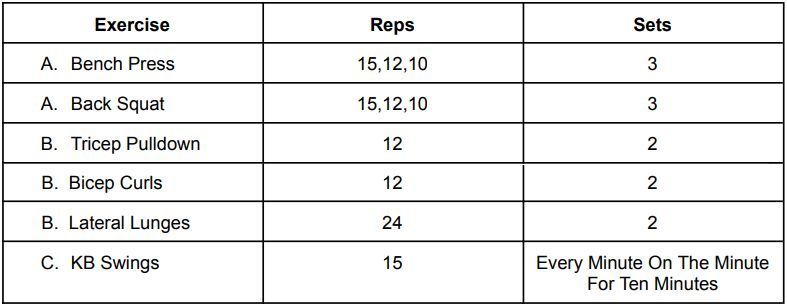Muscular Endurance Training
Muscular endurance is a phase of training that focuses on improving the ability of muscles to sustain repeated contractions over a long period of time. This phase of training involves high repetitions of 12-20 reps and 2-3 sets at a lighter weight.

Why do it?
Adding muscular endurance training to your program will lower your risk of injury and leave you with more energy and better posture throughout the day. This makes it a key component to strength training.
If you are familiar with HIIT (High Intensity Interval Training), then you may know a little bit about muscular endurance training.
HIIT workouts involve circuit training where each exercise in the circuit is high rep.. making it fall into the category of muscular endurance.
Circuits are a great way to make the most out of a small time frame. If you are a busy
professional who only has thirty minutes to get a quick workout in, it can easily be done with a circuit.
If you are planning a full body circuit it could look something like this:
- 3 Rounds:
- 20 yd. Sled Push
- 20 yd. Sled Pull
- 20 Walking Lunges
- 10 Push Ups
- 20 Plank Jacks
If you don’t have access to a sled you can replace the sled with squats and do a circuit like this in your own home or even on vacation if you’re really itching to get something quick in.
A muscular endurance workout that isn’t in the form of a circuit might look something like this:

If you are new to fitness and want to dive into it, start out with bodyweight exercises (squats, lunges, push ups, jumping jacks, mountain climbers, burpees, etc.). It is important to master proper form of these exercises before throwing weights into the mix, especially when performing so many reps.
When creating a plan in this phase, some workouts can have a set rep scheme (3 sets of 20), and some can even go for time.. giving you 45 seconds of mountain climbers or 2 minutes of lunges.
Either way, both of these examples are ways to achieve the same goal.
Note that in order to see results, you must progress through the same exercises (adding more reps or weight over time) versus adding a variety of exercises with nothing to measure your progress on.. So before you go throwing every exercise you can think of into a circuit to see how difficult you can make it, you might want to reconsider.
Muscular endurance is good for everyone. It’s important for the general population of people because it improves daily functions and productivity. Training high reps of different exercises will improve the aerobic capacity of muscles, leaving you with more oxygen when doing everyday tasks like walking up a flight of stairs. Let’s face it, nobody wants to be out of breath just getting from point A to point B.
Endurance athletes such as soccer players, cyclists, runners, swimmers, etc. will benefit from this type of training as well. Athletes will be able to sustain energy for a longer period of time during their games or competitions compared to those who never train in this phase.. and we’re going for gold people!
Each phase of training is important in a program for a variety of reasons. Ever wonder why the huge bodybuilder is winded faster? They have much longer rests between sets and are lacking endurance.
This is the phase they skip over.
Someone who is only lifting heavy weights might be strong, but they are likely to burn out faster throughout the day than those who add this type of endurance training into their workout regimen. Starting with muscular endurance will better prepare your muscles for a heavy strength or hypertrophy phase when you are ready to move on and cycle back through.
About No Limits
No Limits Fitness provides step-by-step programs to help busy adults get the body they’ve always wanted, without restrictive diets or time-consuming workouts, so they can lead more fulfilling lives. Life is a much better experience in a strong, healthy body!
Recent Posts



Luci
Doug
Tasha
No Limits Fitness helps busy professionals lose weight, get stronger and have more energy so they can lead the lives of their dreams...even if they've tried before and failed.
SERVICES
CONTACT INFORMATION
All Rights Reserved | No Limits Fitness | Privacy Policy
